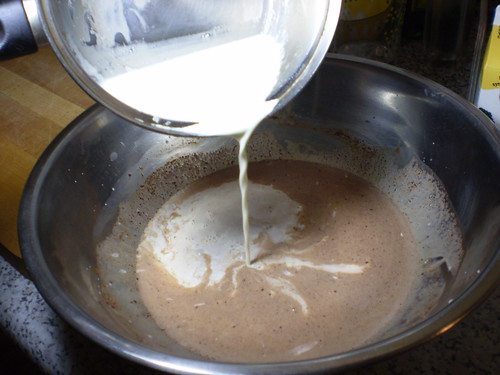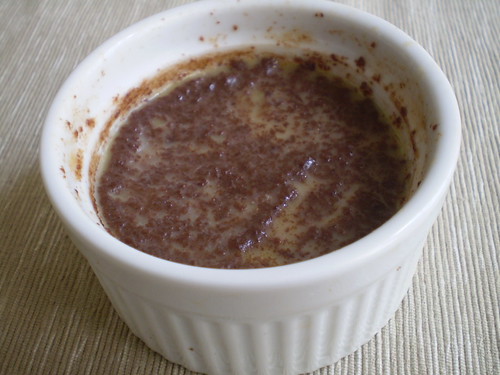There is a lot you can learn about love by making pudding
 The hopeless romantic in me adores all things associated with Valentine's Day, the chocolates, the flowers, and the forced showing of affection. Actually that last part can't be counted on because as we all learn eventually love is fickle and at times fleeting, what can start out so promising and seem so perfect between two people can end up a complete disaster. This is why we should all be forced to make chocolate pudding before starting to date.
The hopeless romantic in me adores all things associated with Valentine's Day, the chocolates, the flowers, and the forced showing of affection. Actually that last part can't be counted on because as we all learn eventually love is fickle and at times fleeting, what can start out so promising and seem so perfect between two people can end up a complete disaster. This is why we should all be forced to make chocolate pudding before starting to date.
 I realized the similarities between turbulent relationships and custard as I sat home with the best of intentions making a batch of chocolate pudding the day before Valentine's. Home-made chocolate pudding can be made on the stove top, but there is the custard-based version that needs to bake in a water-bath before cooling. I grew up eating chocolate pudding that was made for me as a special treat. I was allowed to lick the spoon as a consolation prize for having to wait until the little serving bowls chilled. This was the extent of homemade dessert making in my house, and, I loved every minute of it. But, as I learned this Valentine's Day weekend, real pudding is more complicated than a box of My-T-Fine. Making custard, is an undertaking that one must know a little bit about before naively plowing ahead. When treated wrong, there are several things that can ruin a custard as it bakes, resulting not with the velvety smooth pudding of your dreams, but scrambled eggs.
I realized the similarities between turbulent relationships and custard as I sat home with the best of intentions making a batch of chocolate pudding the day before Valentine's. Home-made chocolate pudding can be made on the stove top, but there is the custard-based version that needs to bake in a water-bath before cooling. I grew up eating chocolate pudding that was made for me as a special treat. I was allowed to lick the spoon as a consolation prize for having to wait until the little serving bowls chilled. This was the extent of homemade dessert making in my house, and, I loved every minute of it. But, as I learned this Valentine's Day weekend, real pudding is more complicated than a box of My-T-Fine. Making custard, is an undertaking that one must know a little bit about before naively plowing ahead. When treated wrong, there are several things that can ruin a custard as it bakes, resulting not with the velvety smooth pudding of your dreams, but scrambled eggs.
 I was heartbroken that my pudding, which was as silky as a bowl of melted chocolate when it went into the oven, didn't have a happy ending. I searched frantically to try and find an explanation as to what went wrong. I sat down and stared in disbelief at the curdled mess in the ramekins. I tried to stir them and make them smooth again, but what's done is done. Then I realized (it being Valentine's Eve and all), that my shock at how this didn't go as expected reminded me of certain past relationships. Sometimes you can't just smooth things over. This is a lesson that all girls and boys should learn about love, because getting over a failed custard is a lot easier than a getting over a broken heart. Just the knowledge that pudding made with the best of intentions can morph into something utterly unattractive if things don't go as planned, might remind one to proceed with some caution in matters of the heart, as well as the oven. (I did finally figure it out what caused the disaster when a friend pointed me to Harold McGee's chapter on custard in On Food and Cooking - now I know for next time, and have adapted the recipe to include the fix).
I was heartbroken that my pudding, which was as silky as a bowl of melted chocolate when it went into the oven, didn't have a happy ending. I searched frantically to try and find an explanation as to what went wrong. I sat down and stared in disbelief at the curdled mess in the ramekins. I tried to stir them and make them smooth again, but what's done is done. Then I realized (it being Valentine's Eve and all), that my shock at how this didn't go as expected reminded me of certain past relationships. Sometimes you can't just smooth things over. This is a lesson that all girls and boys should learn about love, because getting over a failed custard is a lot easier than a getting over a broken heart. Just the knowledge that pudding made with the best of intentions can morph into something utterly unattractive if things don't go as planned, might remind one to proceed with some caution in matters of the heart, as well as the oven. (I did finally figure it out what caused the disaster when a friend pointed me to Harold McGee's chapter on custard in On Food and Cooking - now I know for next time, and have adapted the recipe to include the fix).
I say all this not to scare people off from making chocolate pudding (or falling in love). When done right, it's worth the extra effort (and infinitely better than some second-rate option that comes in a little plastic container). Like love, if it works it should feel comfortable, and something that is so pleasurable you're content to sit at home enjoying it, rather than the kind of dessert that needs to be dressed up with fancy swirls of decorative coulis to make you think it's worth your time. No matter how your chocolate pudding turns out, at least you'll have tried. And if it turns out you fail, you'll know more for next time. And, of course, there's always more pudding in the sea.
Chocolate Pudding Adapted from the Recipes from Home Cookbook, by David Page and Barbara Shinn. Do not tightly cover your baking dish with the ramekins or the temperature of the water bath will rise too high and the steam trapped inside the dish will cook the eggs too quickly causing them to curdle.
2 cups heavy cream 2.5-3 ounces best quality bittersweet chocolate (finely chopped) 3 large egg yolks 1/4 cup sugar 1/2 teaspoon vanilla Pinch of salt
Preheat the oven to 325 degrees Fahrenheit. Set out 4 ramekins and a deep baking dish large enough to hold them and a water-bath.
Bring the heavy cream to a simmer in a saucepan and then remove from the heat. Place the chopped chocolate in a stainless steel bowl and pour half of the cream over the chocolate. Let stand until melted. Stir until mixture is completely smooth and then add the other half of the cream.
Whisk egg yolks, sugar, vanilla and salt in a separate bowl. Gradually whisk in the melted chocolate mixture. Strain the pudding through a fine-mesh strainer and skim off froth on the top.
Pour the pudding into 4 small ovenproof (about 6 oz) ramekins. Place them in a deep baking pan and put pan in the oven. Add enough hot water to the pan to reach halfway up the sides of the ramekins. Cover loosely, with tin foil. Make sure there is room for air to escape and ensure that the pan does not trap the steam. Bake for about 50 minutes, or until puddings look set around the edges, but not quite in the center. Give them a shake to tell.
Remove ramekins from the water bath and let cool to room temperature before placing in the refrigerator to cool completely.